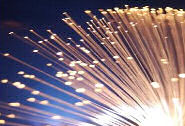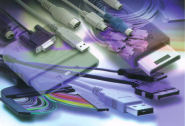EXPERT SERVICES — Terms and Definitions
- Bandwidth, is a measure of the range of frequencies, (frequency spectrum) that is occupied by a single signal. In a communication channel, the rate of information transmitted is directly proportional to the allotted bandwidth.
- The term is often used erroneously to mean Data Rate.
- Crosstalk between two or more conductors is the capacitive (electric fields) and inductive (magnetic fields) coupling between two signal conductors, also known as the aggressor and victim. These two kinds of coupling supply the path for the noise from one conductor to the other.
- Near-end Crosstalk, (NeXT), is the sum of the coupled capacitive and inductive loop currents traveling in a backward direction.
- Far-end Crosstalk, (FeXT), is the difference of the two, moving in a forward direction.
- Current = Ampere = I
- Current refers to the rate of flow of electrons in a circuit. The unit of measure for Current is the Ampere or Amp.
- Current Rating is the maximum level of Amperes a component can pass, usually limited by tstrongperature rise.
- Capacitance is a measure of a Capacitor’s ability to store an electrostatic charge (Electrical Energy). The unit of measure for Capacitance is the farad, and is designated by the letter F.
- Mutual Capacitance, is the capacitance between two conductors (one aggressor, the other victim) and describes the amount of coupling due to the electromagnetic field. The mutual capacitance will inject a current into the victim line proportional to the rate of change of voltage on the aggressor line. Mutual Capacitance it a cause of Crosstalk.
- Capacitor , an electrical component that has the ability to store an electrical charge (Voltage and Current) from a Voltage source.
- Conductance, is the reciprocal of electrical resistance and is a measure of how easily electricity flows through an insulator. Conductance increases as frequency increases. Hence, the ability of a material to be an insulator diminishes as Bandwidth increases. The SI derived unit of conductance is the Sistrongens (symbol S, equal to 1/Omega; alias the "mho"). In certain SI extractions it is designated by the letter "G".
- Electrical conductance should not be confused with conduction, which is the mechanism by which charge flows, or with conductivity, which is a property of a material.
- Data Rate, is the amount of data transferred per second in a communications channel, computer bus or storage device. Data rate is measured in units of bits per second, bytes per second, or baud. When applied to data rate, the multiplier prefixes "kilo-", "mega-", "giga-", etc. always denote powers of 1000, i.e., 64 kbps is 64,000 bits per second. This contrasts with units of storage where they stand for powers of 1024, e.g. 1 KB = 1024 bytes.
- Dielectric Breakdownoccurs when Voltage across a Dielectric Material becomes too great and the Dielectric Material will suddenly begin to conduct Current.
- Dielectric Constant is a measure of the relative effectiveness of a material as an electrical Insulator. It expressed as a numerical value and used to compare materials in terms of their relative Dielectric Loss values.
- Dielectric Loss is the reduction electrical energy due to heat. The lower the Dielectric Loss, the more efficient the Dielectric Material.
- Dielectric Loss Tangent, (dissipation factor), is a measure of the rate of loss of electric power in all dielectric materials, usually in the form of heat. The dissipation factor is expressed as the ratio of the lossy resistive component of the current to the capacitive component of current, and is equal to the tangent of the loss angle.
- Similar to dielectric constant, low Loss Tangents result in a "fast" medium while large Loss Tangents result in a "slow" medium .
- Dielectric Materials are Insulators and are used in the connector industry to harness the electrical energy flowing in a circuit. Dielectric Materials are poor Conductors of Voltage & Current.
- Differential Signal, is a signaling method which uses two conductors (pair) to transmit data. Differential signaling offers faster data rates at reduced signal swing with little to no crosstalk within the signal pair.
- Eye Diagram of a signal is an overlay of the signal waveform over many cycles. Each cycle waveform is aligned to a common timing reference, typically a clock. An eye diagram provides a visual indication of the voltage and timing uncertainty associated with the signal. It can be generated by synchronizing an oscilloscope to a timing reference. The vertical thickness of the overlaid lines in an eye diagram indicate the magnitude of AC voltage noise, whereas the horizontal thickness of the overlaid lines where they cross over is an indication of the AC timing noise or jitter.
- Jitter is the delay between the expected transition of the signal and the actual transition.
- Eye Closure, is a waveform distortion caused by signal attenuation, (insertion loss), as well as noise due to strongI, crosstalk, and signal reflections, (return loss), due to impedance mismatches which tend to reduce an eye pattern opening. A reduced eye opening exhibits the effects of this waveform distortion as risetime degradation with a reduction in peak-to-peak voltage, a reduction of the signaling period, and increased skew & jitter; thus diminishing the signaling characteristics of the transmission line.
- Eye Mask, (Data Mask), the size of the eye opening in the center of an eye diagram indicates the amount of voltage and timing margin available to sample a signal. Therefore, for a particular device, a fixed window can be superimposed onto the eye diagram showing how the actual signal compares to a minimum criteria window, know as the eye mask. If a margin rectangle with width equal to the required timing margin and height equal to the required voltage margin fits into the opening, then the signal has adequate margins.
- Falltime, is the time it takes for a waveform to transition from the high logic state to the low logic state. Falltime is usually measured from 10% to 90% of the total signal swing.
- Fundamental Frequency, is the lowest frequency in a complex waveform.
- 3rd Harmonic, is a frequency at 3X the fundamental frequency of a complex waveform.
- 5th Harmonic, is a frequency at 5X the fundamental frequency of a complex waveform.
- Impedance, -- Impedance represents the magnitude and angle of the ratio of voltage to current within a conductor and varies with frequency; while resistance does not. The unit of measure for Impedance is the Ohm and is designated by the Greek letter Omega.
- Impedance mismatch occurswhen the Impedances of two connected circuits or electrical loads are unequal. As this dissimilarity increases, circuit voltage decreases and little or no power transfer will occur within the circuits.
- Inductance occurs in an electric circuit when changes in the magnetic fieldcreate a Voltage within the circuit Conductors. Inductance is designated by the letter L. Its unit of measure is the Henry, H.
- Mutual Inductance occurs when a changing magnetic field in one conductor induces voltage in a nearby conductor. Impedance is a complex parameter and is the combination of:
- Capacitance, Inductance, and DC Resistance (electromagnetic attributes)
- The direction of the induced Voltage is in the opposite directionof the Current flow that generated it.
- When the magnetic field in the firstconductor becomes steady, (neither expanding or collapsing), Current ceases to flow in the second conductor.
- Self Inductance occurs when changes in the magnetic field induce a Voltage into the conductor and opposes any change in Current flow in the conductor. The direction of the induced Voltage is in the opposite directionof the Current flow that generated it.
- Insulator, a non-conductor that is defined as any material which has infinite Resistance, meaning it does not conduct Voltage or Current.
- Propagation Delay, is the time required for a digital signal to travel from the input port to the output port., or from its injection point to its destination. It is measured in microseconds (µs), nanoseconds (ns), or picoseconds (ps). Propagation delay is important because it has a direct effect on the speed at which a digital device, such as a chipset, can operate. This is true of mstrongory chips as well as microprocessors.
- Resistance = Ohm = R
- Resistance is a two-terminal passive elstrongent whose voltage and current variables are related by Ohm's Law. Resistancerestricts the flow of Voltage & Current in Electrical Circuits.
- Risetime, is the time it takes for a waveform to transition from the low logic state to the high logic state. Risetime is usually measured from 10% to 90% of the total signal swing.
- SATA, is an acronym for Serial Advanced Technology Attachment. It is a computer bus technology primarily designed for transfer of data to and from a hard disk. It is the successor to AT Attachment standard (ATA). This older technology was retroactively renamed Parallel ATA (PATA) to distinguish it from SATA.
- Single-ended Signal, is a signaling method which transmits signals over one conductor.
- Scattering Parameters, (s-parameters), are the reflection and transmission coefficients between the incident and reflected waves and are voltage ratios of the waves. They describe the behavior of a device under linear conditions in the microwave frequency range.
- Insertion loss, (attenuation) is the loss of signal power and voltage via dissipation or absorption by an electrical load in the circuit. Insertion loss is measured in decibels and is represented by the scattering parameter S2,1.
- Return loss, (reflection) is the loss of the signal power transmitted to the electrical load due to that portion being reflected back to the input and is caused by an impedance mismatch in the circuit. The reflected power reduces the power of the transmitted signal. Insertion loss is measured in decibels and is represented by the scattering parameter S1,1.
- TDR, (Time Domain Reflectometry), measures the time a fast pulse edge takes to travel along a section of a transmission line. For TDR, the pulse is observed, after a reflection is created by a impedance mismatch in the transmission line and is superimposed on the transmitted signal at the same end of the transmission line as the transmitter and the time measured is the round-trip propagation time.
- TDT, (Time Domain Transmissometry), measures the time required for a signal pulse injected at one end of a transmission line to reach its destination. For TDT, the pulse is observed at the opposite end of the transmission line from the transmitter and the time measured is the one-way propagation time.
- Voltage = Electromotive Force = E
- Voltage is a force that pushes current through an electrical circuit.
- There are two types of voltages, AC Voltage and DC Voltage.
- Watt, is the standard unit of measurement of electrical power. One watt is one Ampere of current flowing at one Volt and is designated by the letter W.
ist gets it done!




